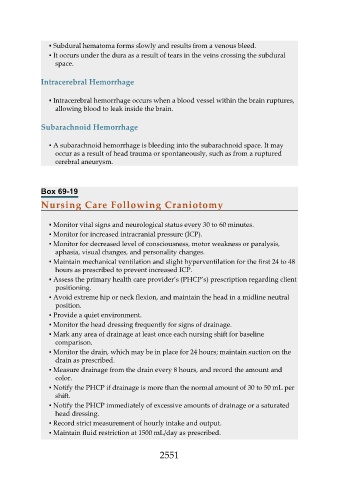Page 2551 - Saunders Comprehensive Review For NCLEX-RN
P. 2551
▪ Subdural hematoma forms slowly and results from a venous bleed.
▪ It occurs under the dura as a result of tears in the veins crossing the subdural
space.
Intracerebral Hemorrhage
▪ Intracerebral hemorrhage occurs when a blood vessel within the brain ruptures,
allowing blood to leak inside the brain.
Subarachnoid Hemorrhage
▪ A subarachnoid hemorrhage is bleeding into the subarachnoid space. It may
occur as a result of head trauma or spontaneously, such as from a ruptured
cerebral aneurysm.
Box 69-19
Nursing Care Following Craniotomy
▪ Monitor vital signs and neurological status every 30 to 60 minutes.
▪ Monitor for increased intracranial pressure (ICP).
▪ Monitor for decreased level of consciousness, motor weakness or paralysis,
aphasia, visual changes, and personality changes.
▪ Maintain mechanical ventilation and slight hyperventilation for the first 24 to 48
hours as prescribed to prevent increased ICP.
▪ Assess the primary health care provider’s (PHCP’s) prescription regarding client
positioning.
▪ Avoid extreme hip or neck flexion, and maintain the head in a midline neutral
position.
▪ Provide a quiet environment.
▪ Monitor the head dressing frequently for signs of drainage.
▪ Mark any area of drainage at least once each nursing shift for baseline
comparison.
▪ Monitor the drain, which may be in place for 24 hours; maintain suction on the
drain as prescribed.
▪ Measure drainage from the drain every 8 hours, and record the amount and
color.
▪ Notify the PHCP if drainage is more than the normal amount of 30 to 50 mL per
shift.
▪ Notify the PHCP immediately of excessive amounts of drainage or a saturated
head dressing.
▪ Record strict measurement of hourly intake and output.
▪ Maintain fluid restriction at 1500 mL/day as prescribed.
2551

